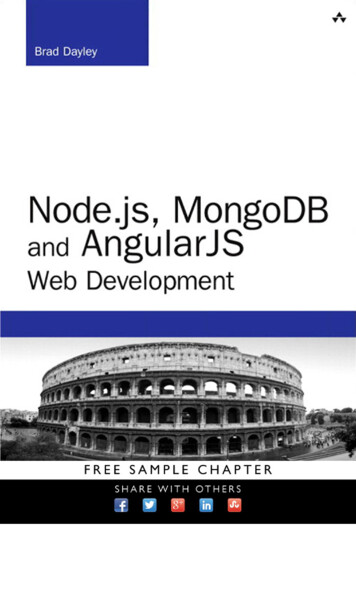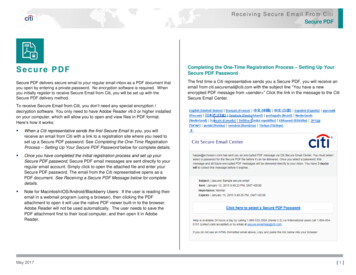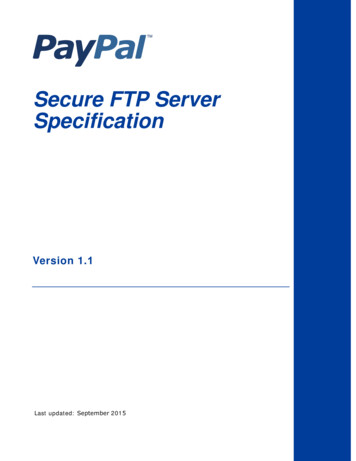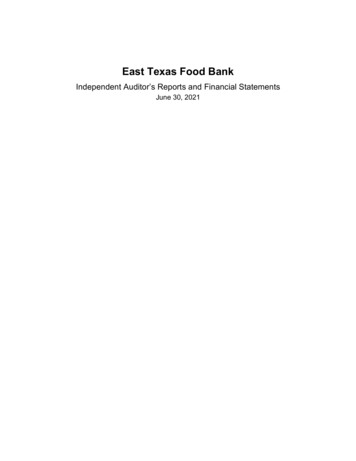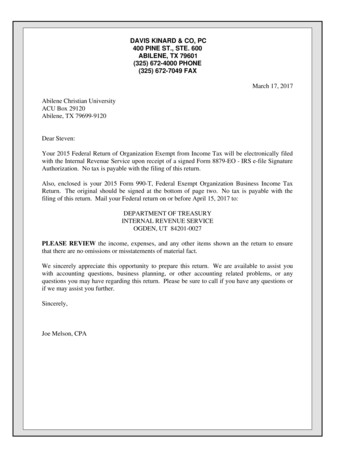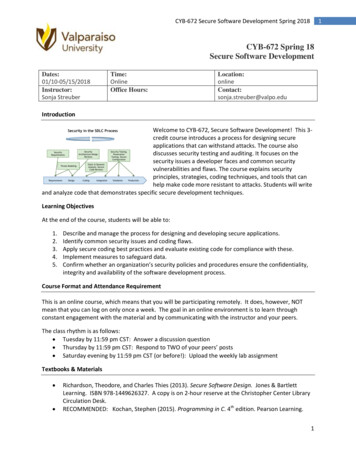
Transcription
CYB-672 Secure Software Development Spring 20181CYB-672 Spring 18Secure Software DevelopmentDates:01/10-05/15/2018Instructor:Sonja StreuberTime:OnlineOffice eduIntroductionWelcome to CYB-672, Secure Software Development! This 3credit course introduces a process for designing secureapplications that can withstand attacks. The course alsodiscusses security testing and auditing. It focuses on thesecurity issues a developer faces and common securityvulnerabilities and flaws. The course explains securityprinciples, strategies, coding techniques, and tools that canhelp make code more resistant to attacks. Students will writeand analyze code that demonstrates specific secure development techniques.Learning ObjectivesAt the end of the course, students will be able to:1.2.3.4.5.Describe and manage the process for designing and developing secure applications.Identify common security issues and coding flaws.Apply secure coding best practices and evaluate existing code for compliance with these.Implement measures to safeguard data.Confirm whether an organization’s security policies and procedures ensure the confidentiality,integrity and availability of the software development process.Course Format and Attendance RequirementThis is an online course, which means that you will be participating remotely. It does, however, NOTmean that you can log on only once a week. The goal in an online environment is to learn throughconstant engagement with the material and by communicating with the instructor and your peers.The class rhythm is as follows: Tuesday by 11:59 pm CST: Answer a discussion question Thursday by 11:59 pm CST: Respond to TWO of your peers’ posts Saturday evening by 11:59 pm CST (or before!): Upload the weekly lab assignmentTextbooks & Materials Richardson, Theodore, and Charles Thies (2013). Secure Software Design. Jones & BartlettLearning. ISBN 978-1449626327. A copy is on 2-hour reserve at the Christopher Center LibraryCirculation Desk.RECOMMENDED: Kochan, Stephen (2015). Programming in C. 4th edition. Pearson Learning.1
CYB-672 Secure Software Development Spring 2018 2A laptop computer with administrative rights.Eclipse C/ C Developer IDE at -ide-ccdevelopers/keplersr2OracleVirtualBox, available at https://www.virtualbox.org/Workload and GradingThis 3-credit course requires significant research and teamwork. You will be completing the following: Attendance & Preparation (10 points per week 150 total): Each Tuesday, answer a questionin the weekly discussion forum (5 pts). Each Thursday, respond to TWO of your peers’responses (5 pts). This activity cannot be made up.Labs (10 points each 150 total): Each week contains one lab assignment about a theoretical,practical, or programming problem based on an assigned case study. Solutions must be postedon Blackboard by 11:59 pm CST on Saturday evening of the week in which they are due.Final Exam (100 points): The final exam will be a randomized 50-question multiple-choice andmultiple-answer exam covering the material throughout the course. It is scheduled by theuniversity registrar and is shown in the Important Semester Dates section on Blackboard and atthe end of the course schedule. You have 60 minutes to complete the exam.You can earn up to 400 points in this course. No extra credit assignments will be given.Letter Grade Conversion: 93%: A90-93%: A73-77%: C70-73%: C-87-90%: B 70%: F83-87%: B80-83%: B-77-80%: C Assignment Submission, Late Work, and Academic Honesty Assignment Submission: All Assignments must be submitted on Blackboard. No emailedAssignments will be accepted.Late Work: Work is considered late if not posted to Blackboard by 11:59 pm CST of the day onwhich it is due. Late work will lose 50% of the grade.Academic Honesty: All work you submit for this course must be your own. You may NOT useanyone else’s words (from blogs, webpages, purchased solutions, etc.) without giving a clear sourcecitation. If you are unsure, consult http://www.plagiarism.org/ or the Writing Center. In addition,you must write and sign with your name the following statement on all course work:I have neither given nor received, nor have I tolerated others' use of unauthorized aid.For more information about Valparaiso University’s Academic Honor Code, case review cycles, andpotential penalties, please refer to pAny work found in noncompliance with the Valparaiso University Honor Code will receive 0 pointsand be referred to the Graduate School.2
CYB-672 Secure Software Development Spring 20183Diversity and InclusionValparaiso University aspires to create and maintain a welcoming environment built on participation,mutual respect, freedom, faith, competency, positive regard, and inclusion. This course will not toleratelanguage or behavior that demeans members of our learning community based on age, ethnicity, race,color, religion, sexual orientation, gender identity, biological sex, disabilities (visible and invisible), socioeconomic status, or national origin. The success of this class relies on all students’ contribution to ananti-discriminatory environment where everyone feels safe, welcome, and encouraged to engage, toexplore, and ultimately, “to embark on a rewarding personal and professional journey” (Pres. Heckler).Title IXValparaiso University strives to provide an environment free of discrimination, harassment, and sexualmisconduct (sexual harassment, sexual violence, dating violence, domestic violence, and stalking). If youhave been the victim of sexual misconduct, we encourage you to report the incident. If you report theincident to a University faculty member or instructor, she or he must notify the University’s Title IXCoordinator about the basic facts of the incident. Disclosures to University faculty or instructors ofsexual misconduct incidents are not confidential under Title IX. Confidential support services availableon campus include: Sexual Assault Awareness & Facilitative Education Office “SAAFE” (219-464-6789),Counseling Center (219-464-5002), University Pastors (219-464-5093), and Student Health Center (219464-5060). For more information, visit http://www.valpo.edu/titleix/ .Access and Accommodation ServicesThe Access & Accommodations Resource Center (AARC) is the campus office that works with students toprovide access and accommodations in cases of diagnosed mental or emotional health issues,attentional or learning disabilities, vision or hearing limitations, chronic diseases, or allergies. You cancontact the office at aarc@valpo.edu or 219.464.5206. Students who need, or think they may need,accommodations due to a diagnosis, or who think they have a diagnosis, are invited to contact AARC toarrange a confidential discussion with the AARC office. Further, students who are registered with AARCare required to contact their professor(s) if they wish to exercise the accommodations outlined in theirletter from the AARC.Academic SupportTo get help, use the Academic Success Center (ASC) online directory (valpo.edu/academicsuccess) orcontact the ASC (academic.success@valpo.edu) to help point you in the right direction for academicsupport resources for this course. Valpo’s learning centers offer a variety of programs and services thatprovide group and individual learning assistance for many subject areas. These learning centers include: Graduate Tutoring Lab: Serves the academic needs of Graduate students – tutors offersuggestions on organization of papers, assist in research and citations, and help inunderstanding difficult assignments. Additional one on one tutoring is also available.Writing Center: Primarily serves the needs of undergraduate students, but is also available forGraduate students. Writing Consultants provide proofreading and editing assistance for papersand assignments.Library Services3
CYB-672 Secure Software Development Spring 20184The librarian best able to help you navigate information resources for independent research oradditional reading is listed on the library research guide for our department. Click the link to LibraryGuides within the Blackboard table of contents for this course.Class CancellationsNotifications of class cancellations will be made through Blackboard with as much advance notice aspossible. It will be both posted on Blackboard and sent to your Valpo e-mail address. If you don’t checkyour Valpo e-mail account regularly or have it set-up to be forwarded to your preferred e-mail account,you may not get the message. Please check Blackboard and your Valpo e-mail (or the e-mail address itforwards to) before coming to class.4
CYB-672 Secure Software Development Spring 20185ScheduleWeek StartDate (all2018)101/10Weekly TopicReadings and Videos (readand watch before Monday)Introduction and Current and EmergingThreatsRichardson 1, 2Other materials as postedon BlackboardRichardson 3Lynda.com Course on CEssential Training: 1-2Other materials as postedon BlackboardRichardson 4Lynda.com Course on CEssential Training: 3-5Other materials as postedon BlackboardRichardson 5Lynda.com Course on CEssential Training: 6-7Other materials as postedon BlackboardRichardson 6Lynda.com Course on CEssential Training: 8-10Other materials as postedon BlackboardRichardson 16Lynda.com Course on CEssential Training: 11-12Other materials as postedon BlackboardRichardson 14Lynda.com Course on CEssential Training: 13-14Other materials as postedon BlackboardRichardson 15Due by11:59 pmCSTR: PostS: ResponseS: LAB 1T: PostR: ResponseS: LAB 2201/15SYSTEMIC THREATS--The NetworkEnvironmentBasics of the C Programming Language301/22SYSTEMIC THREATS--The OperatingSystem EnvironmentData Types, Strings, and Variables in C401/29SYSTEMIC THREATS--The DatabaseEnvironmentBasics of SQL and Database DesignFunctions in C502/05602/12SYSTEMIC THREATS--ProgrammingLanguagesLoops and Arrays in CLow-Level Security in C (and mostprominent attack models)ADVANCED THREATS—Zero Day ExploitsLow-Level Memory-Based Attacks in C702/19ADVANCED THREATS--Secure DataManagementDefenses Against Memory-Based Attacksin C802/26ADVANCED THREATS--Web ApplicationThreatsSQL injection, Cross-site scripting (XSS),input validationSPRING RECESS 03/02 8 pm CST to 03/18 8 am CSTT: PostR: ResponseS: LAB 893/19SECURE DESIGN--Security RequirementsPlanningThreat Modeling and Architectural RiskAnalysis, Good Programming PracticesT: PostR: ResponseS: LAB 9Richardson 7Lynda.com Course on CEssential Training: 15-16Other materials as postedT: PostR: ResponseS: LAB 3T: PostR: ResponseS: LAB 4T: PostR: ResponseS: LAB 5T: PostR: ResponseS: LAB 6T: PostR: ResponseS: LAB 75
CYB-672 Secure Software Development Spring 20186on Blackboard1003/261104/02SECURE DESIGN-- Vulnerability MappingThe Basics of UMLSecure Design Principles, Top DesignFlawsSECURE DESIGN-- Development andImplementationStatic Analysis, Flow Analysis, andContext-Sensitive Analysis12SECURE DESIGN-- Application Review and04/09TestingSymbolic Execution13SECURE DESIGN-- Incorporating SSD with04/16the SDLCPractical Penetration Testing14REDEFINING SECURITY--Personnel04/23Training, A Culture of SecurityFuzzing15REDEFINING SECURITY--A Culture of04/30SecurityCourse SummaryFINAL 05/12COURSE FINAL as posted by Office of the10:00 am Registrar-10:00pm CSTRichardson 8Lynda.com Course on CEssential Training: 17Other materials as postedon BlackboardRichardson 9Other materials as postedon BlackboardT: PostR: ResponseS: LAB 10Richardson 10Other materials as postedon BlackboardRichardson 11Other materials as postedon BlackboardRichardson 12Other materials as postedon BlackboardRichardson 13Other materials as postedon BlackboardT: PostR: ResponseS: LAB 12T: PostR: ResponseS: LAB 13T: PostR: ResponseS: LAB 14T: PostR: ResponseS: LAB 15FINALT: PostR: ResponseS: LAB 116
CYB-672 Secure Software Development Spring 20187APPENDIXStudent Learning Objectives—Graduate School1. Students will understand and practice methods of inquiry and strategies of interpretation withinthe student’s field of study.2. Students will master the knowledge and skills pertinent to the student’s field of study.3. Students will effectively articulate the ideas, concepts, and methods through written and oralpresentation.4. Students will understand the connection between their knowledge and skills on the one hand andtheir professional identity, responsibilities, and demands on the other.5. Students will integrate knowledge and methods of their study with cognates and other disciplines.6. Students will study, reflect upon, and practice ethical behavior and cultural sensitivity as theyrelate to professional and personal responsibility.Student Learning Objectives—Information Technology Program1. To understand and practice methods of inquiry and strategies of interpretation within thestudent's field of study.1A. Students will master several programming environments.1B. Students will learn to identify and isolate problems.2. To master the knowledge and skills pertinent to the student's field of study.2A. Students will acquire an extensive technology related vocabulary.2B. Students will become comfortable using a wide range of technology environments.3. To effectively articulate the ideas, concepts, and methods through written and oral presentation.3A. Students will be taught how to make formal, oral presentations and be required to give 6such presentations during their program.3B. Students will write numerous, thorough papers requiring extensive research. They will berequired to use the services on the writing center.4. To understand the connection between their knowledge and skills on one hand and theirprofessional identity, responsibilities, and demands on the other.4A. Students will understand the implications of legal and professional regulations as they relateto information technology.4B. Students will study how technology can be made available to people that are traditionally lessadvantaged.5. To integrate knowledge and methods of their study with cognates and other disciplines.5A. Students will learn techniques of modeling data from other disciplines.5B. Students will study human factors in IT.6. To practice ethical and cultural sensitivity as it relates to professional and personal responsibility.6A. Students will examine a wide range of ethical issues related to technology and the potentialeffects on people and the environment.6B. Students will explore the relationship between IT and ethnic and cultural diversity.7
Valparaiso University strives to provide an environment free of discrimination, harassment, and sexual . Valpo's learning centers offer a variety of programs and services that . These learning centers include: Graduate Tutoring Lab: Serves the academic needs of Graduate students - tutors offer suggestions on organization of papers .
